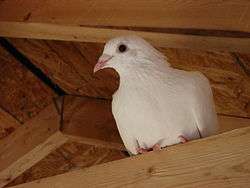Release dove

A release dove, also called white pigeon, is a rock dove bred for size and overall resemblance to a white dove. Pure white doves exist in nature as albinos.(This text needs references). Not all release doves are rock doves and most breeders of doves for various uses do not domestic their birds.
Although many dove release businesses advertise that their birds will be able to safely return home, a few released “doves” can be killed in accidents or by predators before they can make their way back. Most released birds are able to survive a return flight and are viewed similarly to racing pigeons that have been raced for centuries.
The pigeons bred for dove release services are bred for their color, small size, and for their amazing homing abilities and flight speeds.
Dove ceremonies
Release dove handlers each offer their own unique list of release ceremonies to choose from. Some companies will offer either untrained homers, ringnecks, or other types of pigeon or dove. Those types of birds are likely to end up in the claws of a hawk, owl or cat, since they are unable to survive on their own in the wild.[1]
Common wedding release ceremonies
- the "hand release" in which the bride and groom hold two doves which are then released together
- the "flurry" or "flock release" in which the bride and groom release two birds by hand or from a box and then a larger group of doves are released shortly afterward to join them in the sky.
Common memorial release ceremonies
- the "spirit" in which a single dove is released,
- the "trinity" in which three doves are released, followed by a single dove representing the soul of the deceased.
- the "12 dove" in which a single dove is first released, followed by twelve doves.
Types of white doves and pigeons used for release


Many birds have been used for ceremonial releases. But only the Rock Dove has been used traditionally as a messenger of the event that they are released at.
Homing pigeons
There are many breeds of homing pigeons, often called "Thoroughbreds of the Sky". Colored homing pigeons are often used for ceremonial release when pure white homing pigeons are not needed or not available. The most common breed of homing pigeon is bred for racing, and typically flies 480 km (300 miles) to 970 km (600 miles) in a race. The earliest homing pigeons were not used for racing, but to carry messages over long distances in a short amount of time. Today, long-distance homing pigeons fly 1,600 km (1,000 miles) or more. All racers are judged and selected for how quickly they return home.
White homing pigeons
White racing pigeons are most often used for ceremonial release. The pure white pigeon or Rock Dove is associated with all good traits: peace, hope, love, goodwill and family to name a few. They are typically bigger and can be heavier than other Racing Homers as their primary breeding focus has been their ability to fly from many different locations and their looks rather than flight from a few select locations at a high rate of speed. A breed of white Racing Homer called the Belgian Pletinckx can be used for white dove release ceremonies and they make good racers.[2]
Although many people refer to the white homing pigeon as "racing pigeons", not all white ceremonial release pigeons are used for racing. A racing pigeon is different only in that it is bred for the sport of pigeon racing and breeders select for speed, as well as homing ability; they are in fact the same type of bird.
See also
References
- ↑ Gorman, Kate. "Bird lady of Haslet helps to elevate occasions". Star Telegram (Jun 15, 2008). Retrieved 2008-06-25.
- ↑ Perkins, Rix D (March–April 2008). "The Belgian Pletinckx - Not just another white homer". Purebred Pigeon.
External links
| Wikimedia Commons has media related to Columba livia. |
- Professional White Dove Release Association - US, Canada, Great Britain
- White Dove Directory - find a release
- National Pigeon Association (USA)
- American Racing Pigeon Union
- International Federation of American Homing Pigeon Fanciers
- National Pigeon Association (Great Britain)
- Canadian Racing Pigeon Union
- The Canadian Pigeon Fanciers Association
- National White Dove Release Society
- http://www.destinydoves.co.uk white dove release UK